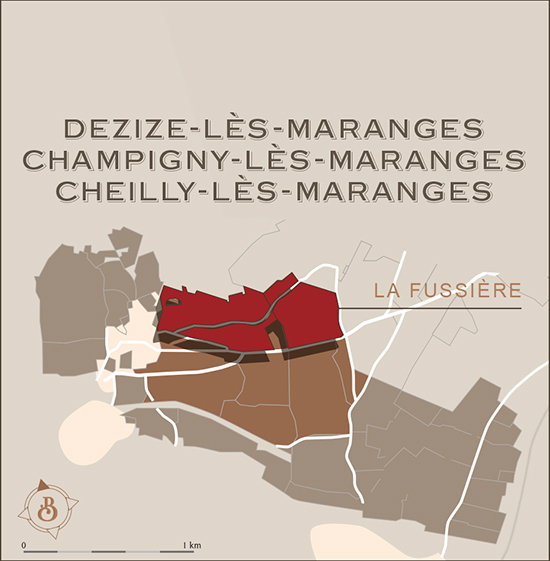Maranges
1er Cru La Fuissière 2018
The Maranges area, forms a link between the Côte-d’Or and the Saône-et-Loire.
Origin
Neighboring the Santenay appellation, the Maranges appellation is located on the southern tip of the Côte de Beaune. Mostly planted in Pinot Noir, the hills forming this vineyard has a south/south-east exposure, with an altitude oscillating between 240 and 400 meters.
"La Fussière", which extends over almost 35 hectares with a beautiful exposure to the south, has a mainly marly soil (gray and blue marls covered with calcareous scree).
The name "Fussière" is derived from the ancient French "Faisse" or "Faissa" which means "land strip". This refers to the terraced winegrowing we find on this steeply slope.
Viticulture
Grape variety: pinot noir
Soils: gray and blue marls covered with calcareous scree.
Orientation: South
Surface area under vine: 0,69 ha
Pruning: Guyot & Cordon de Royat systems
Yield: 48 hL/ha
Average age of the vines: 40 years old.
Vinification
Harvest date: 8 & 9 September 2018.
The grapes were sorted a first time in the vineyard and a second time on the sorting table when they arrived at the winery.
At the winery: the grapes were completely destemmed but not crushed (they were left whole) and were gravity-fed into tanks. Maceration lasted a total of 18 days including 4 days of cold maceration (12°C). Fermentation used indigenous yeasts only (no additives such as enzymes or tannins were used). 5 punchings of the cap. Vinification without sufur.
Ageing
Maturation: aged on the lees for 16 months with no racking using a proportion of 30% new French oak barrels.
Barrels: French oak barrels that had been toasted at low temperatures for a long time for very delicate oaking.
Bottling
Bottling in March 2020, the wine was very gently filtered before being bottled using gravity.
Number of bottles: 4,406.
Vintage
2018 , abundance and excellence
After a winter that was almost too mild, the vintage was notable for two contrasting periods. Spring was sunny and totally devoid of frost, despite some localized episodes of hail, which had major impact on certain plots on the Côte de Nuits, which were hit in June. Then the summer was dry and hot, blocking the ripening process in places. Picking began early, with exceptionally abundant fruit in tip-top condition, offering the potential for some very fine wines.
Ageing potential: from 5 to 10 years.
Tasting notes
With a beautiful dark red color with purple reflections, the nose exudes a very expressive bouquet of floral notes added with mineral touches. The palate is distinguished by its roundness, its structuring tannins and always this minerality. And a very long finish.



